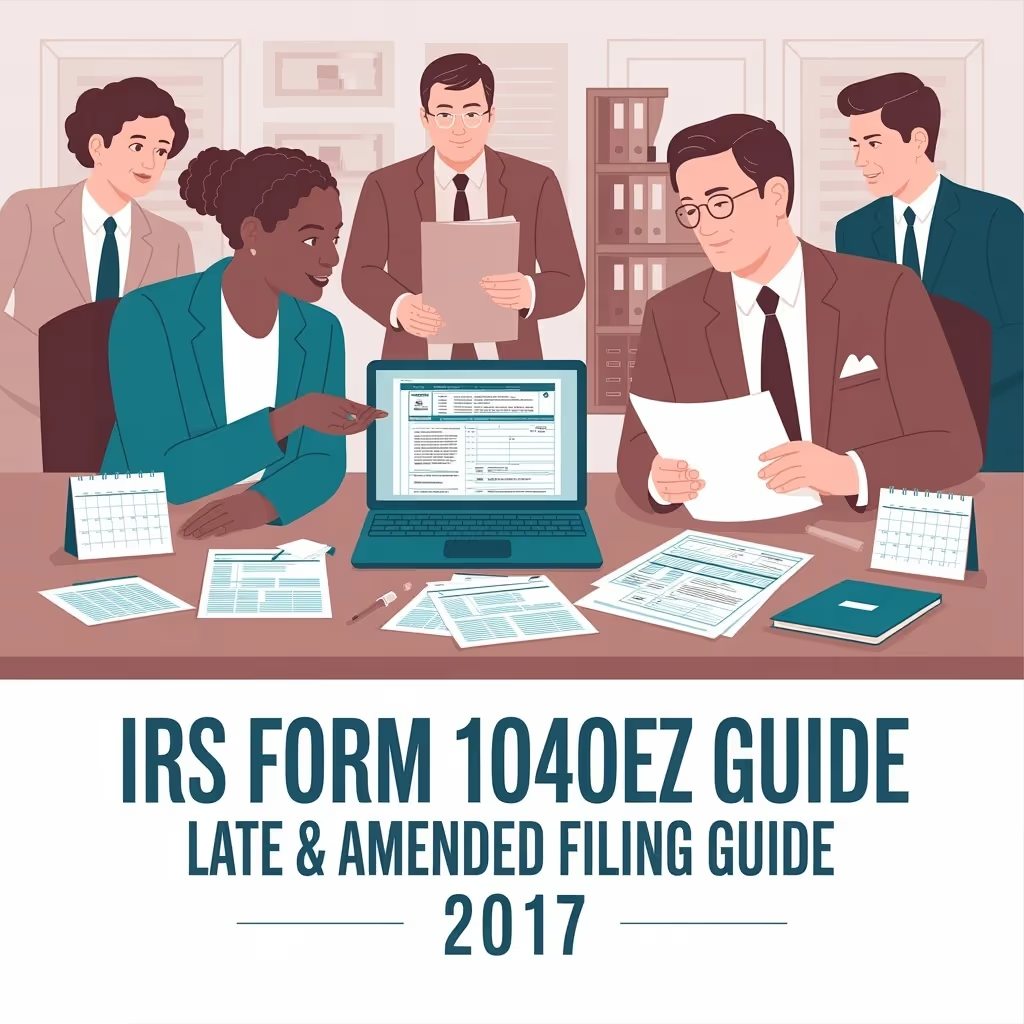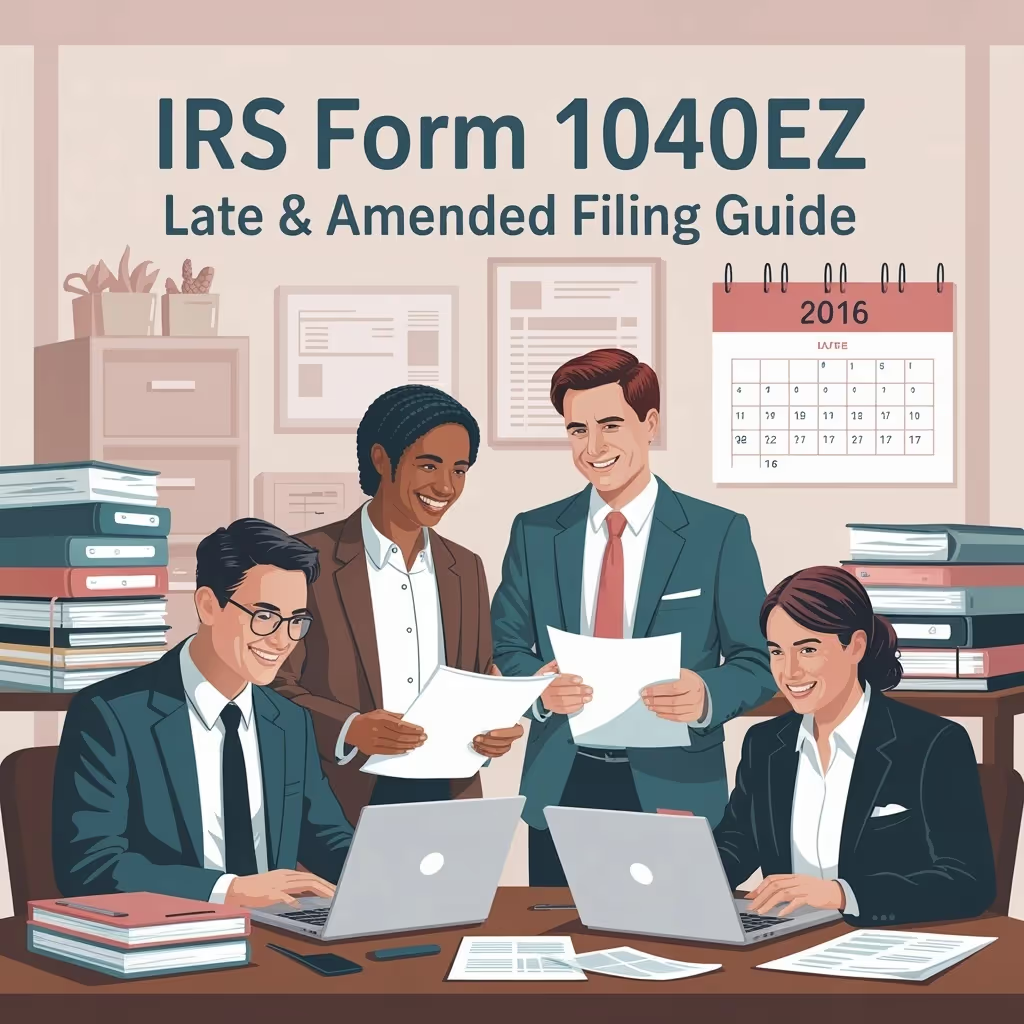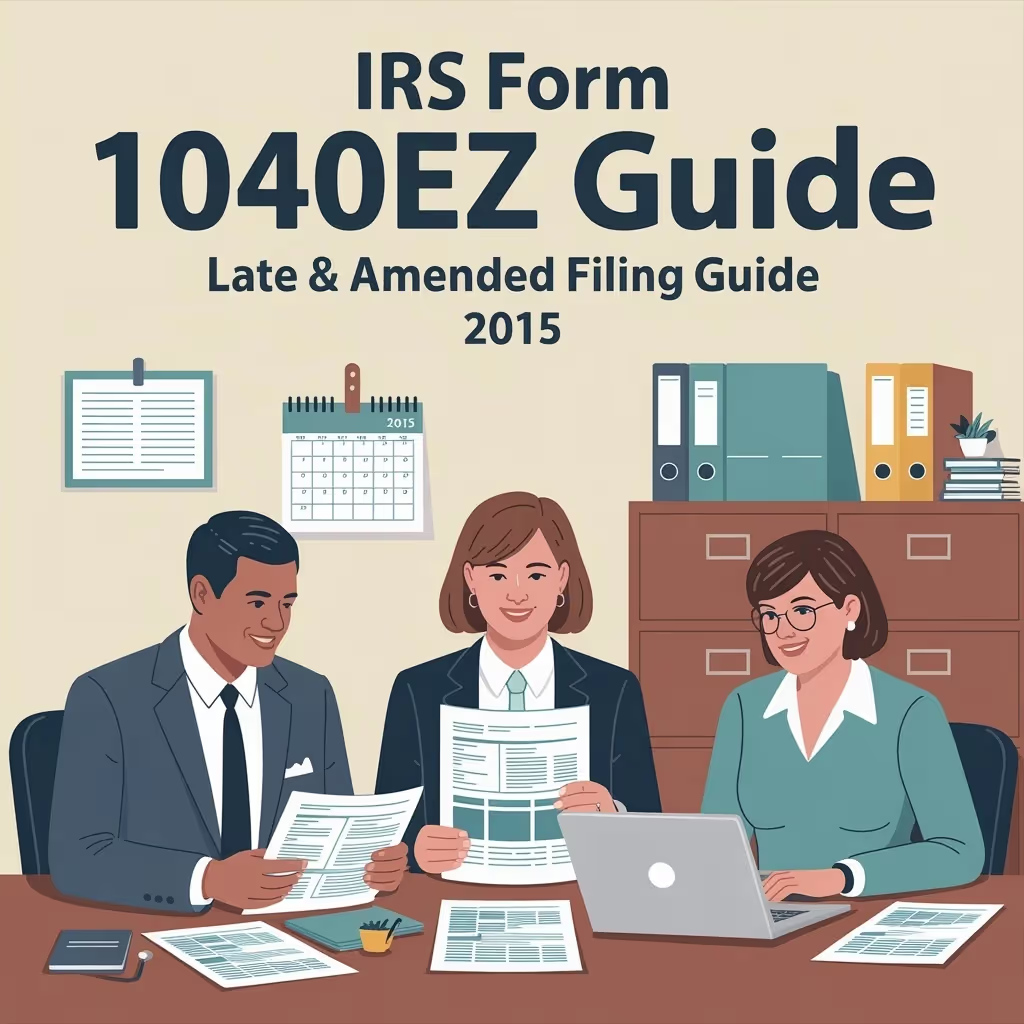
Filing an income tax return can seem complex, especially when determining the correct amount of taxes owed. For the 2010 tax year, the Internal Revenue Service created Form 1040EZ to help eligible taxpayers meet their federal tax obligations more easily. The form applies to single and joint filers with a total income of less than $100,000, no dependents, and limited income sources, such as wages, unemployment compensation, or taxable interest from financial institutions. It allows individuals to report income, verify federal income tax withholding, and calculate tax liability without attaching additional schedules or forms.
Form 1040EZ is ideal for taxpayers seeking a simple filing process without adjustments or deductions. It is unsuitable for filers with complex income, self-employment income, or health savings accounts. The form’s structure helps prevent calculation errors by consolidating the taxpayer identification number, adjusted gross income, and standard deduction into a single streamlined layout. This makes it easier to confirm all details before submitting the income tax return.
According to the IRS official 2010 Form 1040EZ, taxpayers must confirm eligibility and provide accurate data before filing. If you are unsure about your eligibility or how to report total income, our team offers step-by-step guidance to support precise filing.
Understanding Federal Income Tax and Form 1040EZ
Understanding how federal income tax works is essential for anyone preparing an income tax return. The Internal Revenue Service requires individuals to report income and calculate their total tax liability accurately. Form 1040EZ for the 2010 tax year helps eligible taxpayers meet these obligations with a simplified approach.
It is designed for single and joint filers with no dependents who receive wages, taxable interest, or unemployment compensation. The form’s structure ensures clarity when determining adjusted gross income, federal income tax withholding, and the correct amount of taxes owed.
Federal income tax applies to most types of earned and unearned income. Each taxpayer must identify their filing status, report income from all sources, and verify the amounts provided by employers or financial institutions. Taxpayers must also confirm that they qualify to use Form 1040EZ based on their total income and deductions allowed. This ensures that every figure reported to the Internal Revenue Service meets the requirements for federal tax purposes.
- Federal Income Tax Withholding: Employers deduct a portion of wages annually to cover estimated tax obligations.
- Adjusted Gross Income (AGI): The total income minus allowable adjustments affects eligibility for credits and refunds.
- Tax Liability: The amount of tax a filer owes after applying all withholdings and credits.
- Taxes Owed: Any remaining balance due after subtracting withholdings from the total tax liability.
- Federal Tax Purposes: Reporting income accurately and confirming eligibility ensures compliance with federal regulations.
- Employer Reporting: Employers issue tax statements such as Form W-2 to document income and withholdings.
Recognizing how these elements interact helps taxpayers complete their returns accurately. Understanding the role of adjusted gross income ensures the accurate calculation of federal income tax and supports the proper application of credits. Confirming employer details prevents reporting errors that could lead to processing delays or refund adjustments.
Reviewing the correct amounts on each tax statement also helps maintain compliance and prevents underpayment or overpayment. Completing Form 1040EZ requires more than just filling out boxes; it demands understanding how income, deductions, and credits affect tax liability.
A clear grasp of these factors supports accurate reporting, reduces filing errors, and simplifies the process of preparing an income tax return. By mastering these basics, taxpayers gain the confidence to meet all federal tax purposes efficiently and accurately. Consistent reporting and careful review ensure the return accurately reflects all income sources and withholdings.
Pre-Filing Requirements for the 2010 Tax Year
Before completing Form 1040EZ, taxpayers must confirm their eligibility, gather the required documentation, and verify details with their employers and financial institutions. The 2010 version applies only to those with straightforward financial situations. Careful preparation ensures income records, identification details, and documentation meet Internal Revenue Service requirements and support accurate calculation of taxes owed or refunds due.
- Eligibility Requirements: Single or married filing jointly, under age 65, and not blind. Total income must be below $100,000, and taxable interest must not exceed $1,500. Filers cannot claim dependents or adjustments to income. Confirming these details ensures the taxpayer can use this simplified income tax return.
- Filing Status: Only single and joint filers can use Form 1040EZ. Single filers report their income and federal income tax withholding, while joint filers must include both spouses’ wages and verify Social Security Numbers before signing. Selecting the correct filing status ensures an accurate calculation of tax liability and helps prevent errors in filing.
- Taxpayer Identification: Each filer must use an accurate Social Security Number (SSN) or Taxpayer Identification Number (TIN). Taxpayers must ensure that their identification number matches the records of the Social Security Administration so that the Internal Revenue Service can apply federal income tax withholding correctly. Verifying identification early helps prevent refund delays and correspondence with the agency.
- Income Sources: Acceptable income sources include W-2 wages, taxable interest from financial institutions, and unemployment compensation. Filers with self-employment income, capital gains, or other complex income must use Form 1040A or Form 1040. Limiting income to these sources ensures compliance with the eligibility requirements for Form 1040EZ.
- Documents Needed: Gather all supporting forms before filing, including Form W-2 (wages and tax withholding), Form 1099-INT (interest income), and Form 1099-G (unemployment compensation). Include bank account details for direct deposit and certification request forms supporting credit eligibility. Organized documentation helps confirm total income and supports accurate filing.
- Employer Data: Review all information on each tax statement to confirm accuracy. Names, income totals, and employer identification numbers must match across documents. Matching employer data with reported income helps prevent rejections and delays in refund processing.
Careful pre-filing preparation helps taxpayers understand their responsibilities and file accurately. By confirming eligibility, collecting documentation, and validating employer information, filers can complete Form 1040EZ efficiently and confidently. Organizing records ensures that the income tax return accurately reflects the correct amount owed or refunded, without unnecessary delays or errors.
Step-by-Step Guide to Completing Form 1040EZ
Completing Form 1040EZ for the 2010 tax year involves entering accurate data, verifying totals, and confirming eligibility for every line item. Each entry directly affects federal income tax withholding, adjusted gross income, credits, and final tax liability. Reviewing each section carefully ensures the income tax return reflects the correct amount owed or refunded.
Step 1: Gather Your Records and Verify Identification
Start with organization. Collect all necessary forms, including W-2s, 1099-INT, and 1099-G, to confirm income and withholdings. Verify your Social Security Number (SSN) or Taxpayer Identification Number (TIN) and ensure it matches records with the Social Security Administration. Keep bank account information nearby if you plan to use direct deposit for your refund.
Step 2: Provide Personal Details
In the top section, list your full legal name and current address exactly as they appear on your official identification. Include your SSN or TIN; if filing jointly, add your spouse’s details. Double-check spelling and numbers and address accuracy to prevent processing delays and ensure timely delivery. Consistency between personal data and employer records is critical for federal tax purposes.
Step 3: Choose Your Filing Status
Select the box for your appropriate filing status.
- Single: Choose this if you were unmarried on December 31, 2010.
- Married Filing Jointly: Choose this if you were married on December 31, 2010, and both spouses meet eligibility criteria. Your filing status affects your standard deduction, taxable income, and calculated total tax.
Step 4: Report Income Sources
Record all qualifying income that meets Form 1040EZ requirements:
- Wages and Salaries: Add income from every W-2 issued by your employers.
- Taxable Interest: Report total interest of $1,500 or less from financial institutions.
- Unemployment Compensation: Include benefits listed on Form 1099-G. Add all amounts to determine your total income, ensuring they match your employer and financial institution tax statements.
Step 5: Calculate Adjusted Gross Income
Combine all income sources. Since Form 1040EZ does not allow adjustments or deductions beyond the standard deduction, the result becomes your adjusted gross income (AGI). This figure is essential for determining your tax bracket and credit eligibility. A single incorrect entry may affect your entire tax liability.
Step 6: Apply the Standard Deduction
Form 1040EZ automatically includes the standard deduction and personal exemption in one line. For 2010, single filers enter $9,350 and married joint filers enter $18,700. If someone else can claim you as a dependent, use the worksheet on the back of the form to determine the correct deduction. Enter this value carefully to confirm your taxable income is calculated accurately.
Step 7: Determine Taxable Income
Subtract the deduction from your total income. If the result is less than zero, enter “0.” This number is your taxable income, which determines your final tax amount using the official IRS tax table. Double-check the subtraction to avoid misreporting your federal tax liability.
Step 8: Compute Your Tax and Record Payments
Use the tax table from the 2010 IRS Form 1040EZ reference guide to calculate your federal tax amount. Enter the figure based on your taxable income and filing status. Next, add your total payments, including federal income tax withheld from your W-2s and any applicable tax credits such as the Earned Income Credit (EIC). Accurate totals ensure the correct comparison between taxes owed and credits received.
Step 9: Identify Refund or Balance Due
If your total payments and credits exceed your tax, the difference is your refund. Provide your bank routing and account numbers for direct deposit. If you owe money, include payment when filing or schedule an electronic withdrawal to settle your debt. Paying on time prevents additional interest or correspondence from the Internal Revenue Service.
Step 10: Final Review and Submission
Review all entries for accuracy before signing. Verify that the names, identification numbers, and amounts in the supporting documents match. When filing jointly, both spouses must sign the return. Keep a copy for your records and file electronically for faster confirmation and refund processing.
Completing each step thoughtfully ensures accuracy across income, deductions, and credits. Organized preparation and verified information reduce the likelihood of errors and promote the smooth processing of your federal income tax return. A careful review of every line builds confidence that your 2010 Form 1040EZ is complete and compliant with all federal tax requirements.
Filing Options: E-File or Paper Filing
Taxpayers completing Form 1040EZ for the 2010 tax year can choose between electronic filing (e-file) or paper filing. Each option offers distinct advantages depending on the filer’s comfort level, access to technology, and need for processing speed. Reviewing how each method works ensures complete submission and timely acknowledgment from the Internal Revenue Service.
Electronic Filing (E-File)
E-filing is the most efficient and secure way to submit a federal income tax return. This method enables taxpayers to submit their Form 1040EZ electronically, reducing processing time and minimizing data-entry errors.
Filers receive immediate confirmation that the Internal Revenue Service has accepted their returns, ensuring timely submission and accurate processing. Most e-file platforms also perform error checks to help confirm accurate reporting of total income, adjusted gross income, and federal income tax withholding.
Taxpayers who file electronically can also select direct deposit for refunds, which typically arrives within 10 to 21 days. Those who owe money can schedule an electronic payment for the due date, ensuring compliance while avoiding missed deadlines.
E-filing supports single and joint filers, provided that all identification numbers and banking details match the official records on file with the IRS. This option benefits individuals who value convenience, confirmation, and faster turnaround times.
Paper Filing
Paper filing remains acceptable for taxpayers who prefer to submit a physical return. Filers must print Form 1040EZ clearly, using black ink and legible handwriting, and attach all required documentation, such as Form W-2 and 1099 statements. Each return should include accurate Social Security Numbers, signatures, and payment if taxes owed are indicated.
Taxpayers should confirm the correct address based on their residence and include a payment if applicable when mailing the return. Sending returns via certified mail provides proof of submission while safeguarding against lost documents. While processing paper returns may take longer, it remains suitable for filers with limited internet access or those who prefer traditional filing methods. Careful review of all attachments and calculations is essential to ensure accurate processing.
Both e-filing and paper filing meet federal tax purposes, provided each form is complete and signed before the due date. The correct method depends on personal preference, access, and desired processing speed. Regardless of the approach, accuracy and organization remain the key to a successful filing experience.
Payment and Refund Guidance
After finalizing Form 1040EZ, taxpayers must determine whether they owe additional tax or qualify for a refund. Every outcome depends on how total payments, credits, and federal income tax withholding compare to the tax liability reported. Choosing the proper payment or refund option ensures a timely resolution and a smooth filing experience. Reviewing all figures before submission helps confirm the return reflects correct income, credits, and tax calculations.
Paying Taxes Owed
If the return shows an amount due, taxpayers can settle their balance using several secure methods:
- Electronic Funds Withdrawal (EFW): When filing electronically, you may authorize an automatic payment from a checking or savings account on the filing date. This option removes the need for mailing checks and provides instant confirmation.
- Electronic Federal Tax Payment System (EFTPS): The Electronic Federal Tax Payment System (EFTPS) allows for the scheduling of payments in advance and provides a comprehensive history of all federal transactions. It is a free and secure system operated by the U.S. Department of the Treasury.
- Check or Money Order: Paper filers can mail payments payable to “United States Treasury.” For accurate processing, include your name, address, phone number, Social Security Number, and “2010 Form 1040EZ” on the memo line.
- Credit or Debit Card: Some third-party processors accept online or phone payments. Small service fees may apply, depending on the provider.
Receiving a Refund
If total payments exceed the calculated tax, the taxpayer qualifies for a refund. The Internal Revenue Service provides two convenient delivery options:
- Direct Deposit: Funds are transferred directly to your bank account within 10 to 21 days.
- Paper Check: Refunds are mailed to the address listed on the return and may take an additional time to process.
Accuracy is critical when entering routing numbers, account details, or mailing addresses. Verifying these details before submission helps ensure prompt delivery and avoids refund reissuance requests. Confirming all figures and selecting reliable delivery methods helps taxpayers complete the filing process efficiently and confidently.
Common Errors That Delay Processing
Even minor mistakes on Form 1040EZ can delay refunds or trigger correction notices from the Internal Revenue Service. Reviewing the return carefully ensures that every income source, tax statement, and credit reflects accurate information. Attention to detail supports the correct calculation of total income, federal income tax withholding, and final tax liability.
- Incorrect Social Security Number: Confirm that each Social Security Number or Taxpayer Identification Number matches official records. Even a single digit entered incorrectly can delay processing or result in a refund misapplication.
- Incorrect Filing Status: Only single and joint filers can use Form 1040EZ. Selecting an ineligible status, such as "head of household," results in a return rejection or reclassification.
- Mathematical Errors: Add wages, taxable interest, and adjustments with care. Miscalculating total or adjusted gross income can result in the incorrect amount of federal tax being owed or refunded.
- Missing Required Documents: Please attach all relevant forms, such as Form W-2, 1099-INT, or 1099-G. These confirm income reported from employers, financial institutions, or unemployment benefits.
- Inaccurate Withholding Amounts: Compare federal income tax withholding on your return with figures on your W-2. Differences may result in changes to refund amounts or create an unexpected balance due.
- Unsigned Tax Returns: Returns lacking signatures remain incomplete. Both spouses must sign and date the form to finalize submission when filing jointly.
- Incorrect Direct Deposit Information: Verify routing and account numbers before filing. Errors in banking details can delay refunds or lead to mailed checks instead of electronic deposits.
- Unreported Income: Include all taxable sources, including interest income and unemployment compensation. Omitting any income may prompt the IRS to adjust your return.
Completing a thorough review before filing helps ensure faster processing and reduces the need for correspondence with the IRS. Confirming all entries, attachments, and totals promotes accuracy, strengthens compliance, and leads to a smoother tax filing experience. Double-checking each section before submission helps taxpayers avoid delays and maintain accurate federal tax records.
Filing Tips for Students, First-Time Filers, and Low-Income Earners
Filing an income tax return becomes more manageable with thorough preparation and a clear understanding of the process. Students, first-time filers, and low-income earners often qualify to use Form 1040EZ if they meet specific requirements. Knowing how to organize documents, verify filing status, and claim eligible credits supports accuracy and timely submission. The table below outlines key areas to review before filing.
Federal Tax Filing Guidance by Area
Income Records
Collect Forms W-2 and 1099 from all employers or financial institutions. Total income includes wages, tips, taxable interest, and unemployment compensation. Accurate reporting ensures correct tax liability.
Filing Status
Only single and joint filers under age 65 and not blind may use Form 1040EZ. Confirming the correct filing status determines eligibility for standard deductions and affects total federal income tax withholding.
Dependency Determination
Students may be claimed as dependents on their parents’ returns. Verify dependency status before filing to avoid duplicate claims or credit disqualification.
Tax Withholding Review
Compare federal income tax withholding on Form W-2 against expected liability. Over-withholding can result in refunds, while under-withholding may cause tax liabilities. Adjust future withholdings based on your review results.
Eligible Credits
Review qualifications for the Earned Income Credit or Making Work Pay Credit. Meeting income and filing criteria can reduce taxes owed or increase refunds for eligible filers.
Education Income
Taxable income includes scholarship funds used for room, board, or personal expenses. However, funds used for tuition, fees, and books are generally excluded from taxable income.
Identification Numbers
Ensure that all Social Security Numbers or Taxpayer Identification Numbers are correct. Errors can delay return processing and affect the distribution of credits or refunds.
Careful preparation helps new and low-income filers avoid mistakes and ensures accurate reporting for federal tax purposes. Reviewing income details, confirming eligibility, and verifying all identification numbers creates a strong foundation for timely and compliant filing. Staying organized each year strengthens financial literacy and reduces challenges in future filings.
Frequently Asked Questions
What tax forms are required when filing Form 1040EZ for the 2010 tax year?
Taxpayers using Form 1040EZ must attach all relevant tax forms that report income or withholding. This includes Form W-2 for wages, Form 1099-INT for interest, and Form 1099-G for unemployment compensation. Each information return helps verify income reported to the Internal Revenue Service. Failure to include all required forms can delay processing or result in correction notices, affecting refund timelines and overall federal tax compliance.
Can I claim the Earned Income Credit on Form 1040EZ?
Filers may claim the Earned Income Credit (EIC) if they meet income limits and eligibility criteria. Single and joint filers with qualifying wages or source income may be eligible for this income credit. The EIC helps reduce federal tax owed or increase refunds for eligible taxpayers. Confirming all filing requirements and reviewing income limits ensures accurate calculation and avoids processing delays during review.
Are nonresident aliens eligible to file Form 1040EZ?
Nonresident aliens typically cannot file Form 1040EZ because their tax situations involve different reporting requirements and treaties. Individuals with foreign-source income, dual-status residency, or complex deductions must use alternative forms for international taxpayers. Form 1040NR or 1040NR-EZ generally applies to foreign persons with U.S. income. Reviewing eligibility before filing ensures correct classification, avoids unnecessary correspondence, and supports accurate reporting under federal tax law.
How does uncollected Social Security or Medicare tax affect my filing?
Uncollected Social Security or Medicare tax from tips or wages must be reported separately. While Form 1040EZ is designed for simple returns, taxpayers with uncollected Social Security or Medicare taxes should use Form 1040. Reporting these amounts ensures proper crediting toward future benefits and compliance with federal tax obligations. Omitting this information may result in errors or additional review from the Internal Revenue Service.
Can I still claim the First-Time Homebuyer Credit from prior years?
The First-Time Homebuyer Credit applied to specific purchases in prior years and required repayment beginning in 2010 for homes bought in 2008. Taxpayers repaying the credit must file Form 1040, not Form 1040EZ, and attach the required schedule. Reviewing the original purchase year determines whether repayment or additional documentation applies. Using the correct tax form ensures accurate reporting and prevents delays during the federal review process.
What should I do if I need an automatic extension to file my taxes?
Taxpayers unable to file by the April deadline may request an automatic extension using Form 4868. This extension provides additional time to submit tax forms, but does not extend the deadline for paying any federal tax owed. Payment should accompany the request to avoid added interest or penalties. Filing electronically helps confirm acceptance quickly and ensures compliance with Internal Revenue Service deadlines while preventing late submission complications.
Do first-time filers receive a pre-screening notice before their application is processed?
No, the Internal Revenue Service does not issue a pre-screening notice before reviewing returns. Each income tax return is processed based on reported income, withholding, and eligibility for credits or refunds. New filers should ensure all identifying information and other forms are accurate before submission. Maintaining copies of prior years’ filings, W-2s, and other tax documents supports accuracy and smooth processing during initial filing seasons.



























